Whether you’re ready to get started or would like to know more, we’re here to help.
By Feann Torr, carsales.com.au
Subaru claims its sixth generation Impreza is an ‘all-new’ model, but you wouldn’t know it. The Impreza has been a mainstay for the Japanese brand for more than 30 years, but times have changed since it was first introduced, and SUVs have taken over as the default choice for small car buyers.
As such, even though the company claims the 2024 Subaru Impreza is a wholesale model change, it is more of a re-skin as it still shares the same fundamental basics – the platform, engine, and transmissions – as its predecessor.
There is some new-ness that commands attention, like the big digital display in the cabin and several other subtle improvements, but there’s also a sense of familiarity about the Impreza that indicates Subaru has other priorities.
Let us explain why.
How much does the Subaru Impreza cost?
The latest Subaru Impreza was first revealed at the Los Angeles Motor Show in 2022 and has only just arrived in Australian showrooms.
It is available in three model grades – 2.0L, 2.0R and 2.0S – all of which share the same mechanical configuration, are exclusively offered with an automatic transmission and only available in a hatchback body style.
The range starts at $31,490 plus on-road costs for the entry-level 2.0L, rises to $34,990 (plus ORCs) for the mid-spec 2.0R and tops out at $37,990 (plus ORCs) for the 2.0S we’re testing here. That is until the flagship, warmed-up Impreza RS arrives later.
The higher prices make it one of the more expensive Asian hatchbacks in the small-car segment against rivals such as the top-selling Toyota Corolla (from $29,610), Hyundai i30 (from $24,000), Mazda3 (from $30,470) and Kia Cerato (from $27,060). However, none of these offer Subaru’s trademark all-wheel drive – except the high-performance GR Corolla… but that costs an eye-watering $64K.
Warranty provisions are typical at five years and unlimited kilometres, but there’s only one year of complimentary roadside assistance (linked to a car club membership in your state, such as RACV or NRMA), which is below average.
Service costs aren’t as low as the Corolla’s (few are) and you’ll pay an average of $475 per annual service or $2372 over five years or 75,000km, with 12-month/15,000km intervals.
What equipment comes with the Subaru Impreza?
The entire 2024 Subaru Impreza range comes with an extensive list of standard equipment, with all grades now fitted as standard with a jumbo 11.6-inch portrait-style central touchscreen, wireless phone charger, smart key and push-button start, automatic (dusk-sensing) LED headlights, LED taillights, power-folding door mirrors and USB-A and USB-C ports.
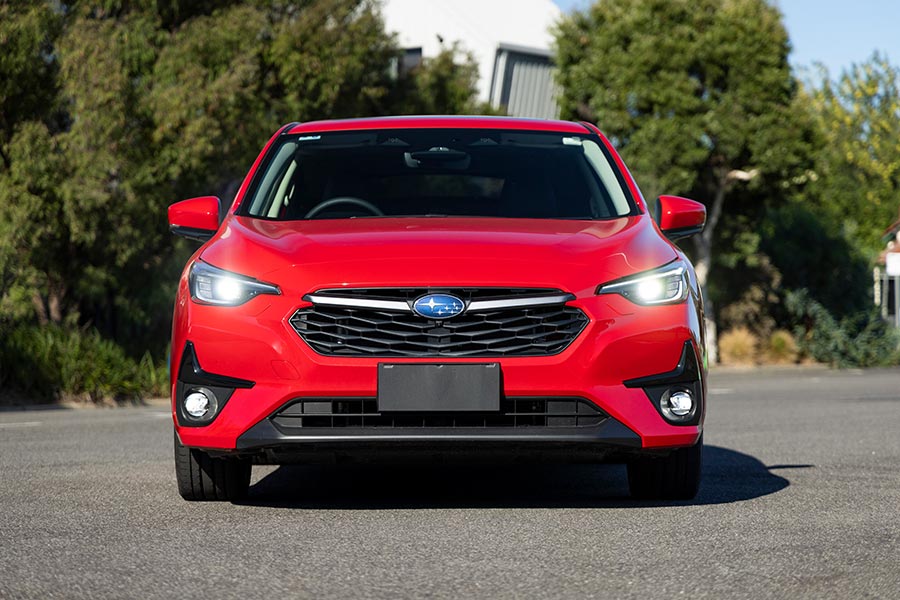
Dual-zone climate control, 17-inch alloy wheels, tinted rear windows, rain-sensing windscreen wipers, cloth-trimmed seats and both wireless Apple CarPlay and Android Auto are also standard across 2024 Impreza range, while this top-spec 2.0S adds embedded satellite-navigation, 18-inch alloy wheels and heated, leather-trimmed front seats – power-adjustable but only for the driver.
Also on the flagship model, it comes with an electric sunroof, 10-speaker Harman Kardon audio system, self-levelling headlights with high-beam assist, LED front fog lights, aluminium-faced sports pedals, and an auto-dimming rear-view mirror.
What technology does the Subaru Impreza feature?
Without doubt, the headline act inside the cabin of the 2024 Subaru Impreza is the portrait-style central touchscreen. It’s bigger than all its rivals’, it looks great – especially with Apple CarPlay or Android Auto – and the physical temperature controls mean you don’t have to drill into menus to quickly adjust the air-conditioning.
There’s no head-up display or a digital instrument cluster, which is disappointing given how similar the cabin design is to its predecessor’s. It’s almost like serving up eggs benedict without the rich buttery sauce.
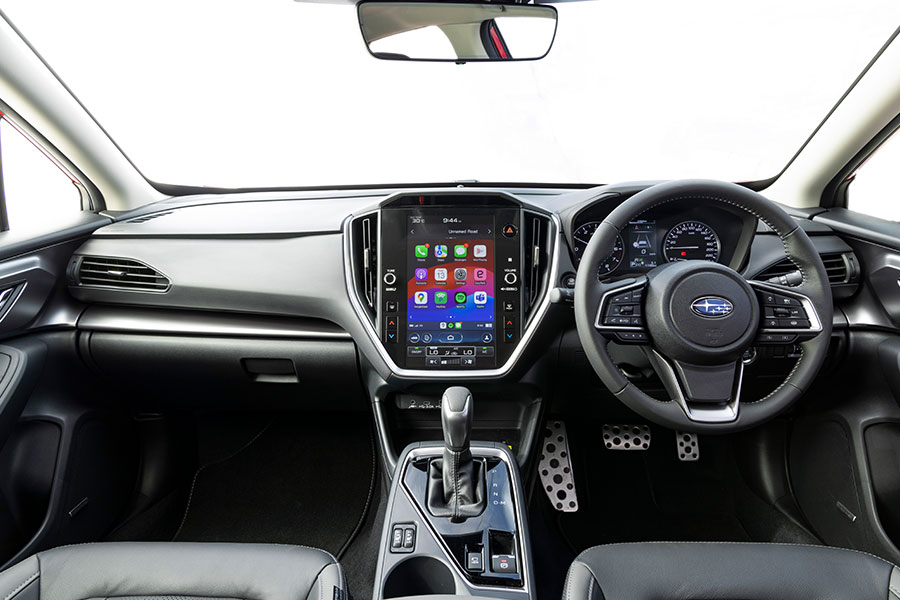
The analogue dials are simple and logical, and the compact 4.2-inch digital screen wedged between them offers plenty of info. Although the reversing camera is detailed and the overhead 360-degree view is helpful when parking in tight spaces, this doesn’t feel like a particularly advanced or innovative vehicle.
What is the Subaru Impreza like inside?
Beyond the tablet-style screen, there’s nothing new or exciting about the 2024 Subaru Impreza’s cabin.
While there are some cheap plastics scattered around, there’s also plenty of soft touch materials in the most tactile areas which elevates the sense of impeccable quality in its fit and finish.
The basic ergonomics are spot-on, from the comfortable and shapely front seats to the adjustability of its driving position and layout of the switchgear and controls. The driver gets eight-way power adjustment (with lumbar support), but the front passenger only has manual adjustments which smells of cost-cutting in this top-shelf variant.
That said, the 10-speaker Harmon Kardon audio system is good and, together with the electric sunroof, lends the cabin an upmarket ambience.
Apart from the large central bin and wireless device charging pad, storage solutions are average, but dual USB ports (both A and C connections) and an AUX port are handy. The tablet screen has voice recognition for certain functions, but it can be hit and miss.
If you’re upgrading from the previous fifth-generation Subaru Impreza you may feel a little short-changed when you notice several carryover interior parts, including the steering wheel.
The cabin’s overall look and feel is eerily similar to the ‘old’ Impreza and, together with a lack of air-vents for rear seat passengers and a 15 per cent smaller boot than before, it all feels a bit underwhelming.
How safe is the Subaru Impreza?
The 2024 Subaru Impreza has yet to be assessed by independent safety authority ANCAP, but it does come with an impressive safety suite, including nine airbags and Subaru’s latest ‘Eyesight’ sensory array.
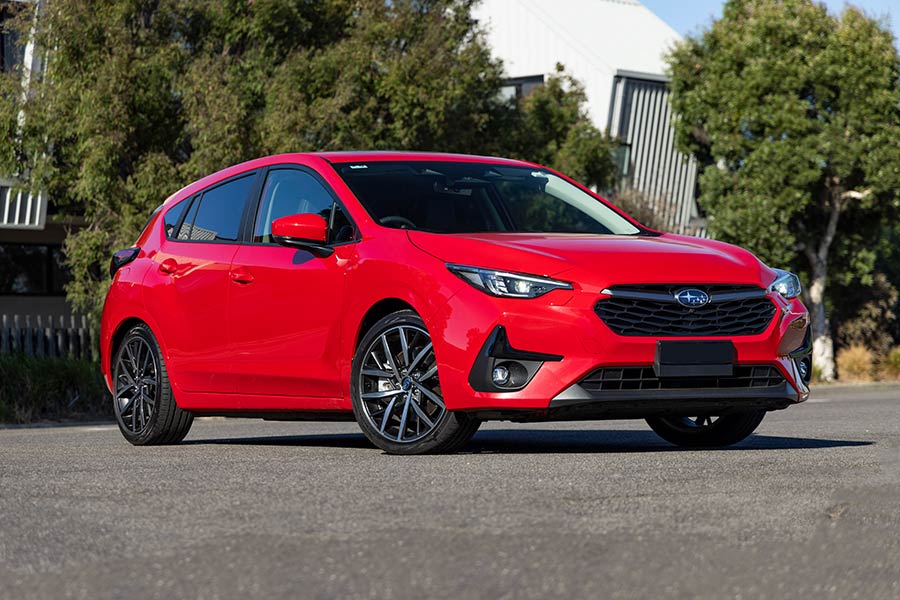
This includes an upgraded dual or ‘stereoscopic’ camera system mounted at the top of the windscreen that enables autonomous emergency braking (AEB), adaptive cruise control and automatic steering on the freeway via lane centring and lane departure prevention.
It also gets autonomous emergency steering and an intelligent speed-limiter via road sign recognition, plus there’s a blind spot monitor to alert drivers to cars they may not see behind and beside them, and rear cross traffic alert that’ll warn drivers of approaching cars when reversing out of tight or vision-limited car parks.
A facial recognition system is coupled with a distraction warning system that beeps if you take your eyes off the road for more than a few seconds, which can be annoying when trying to hold a conversation on dead-straight freeways, where the auto steering system does a good job of keeping the car on the straight and narrow.
What powers the Subaru Impreza?
Along with its ‘symmetrical AWD’ system (which is no longer a genuine full-time all-wheel drive system without a manual transmission), another signature powertrain feature of the 2024 Subaru Impreza is its flat four-cylinder engine.
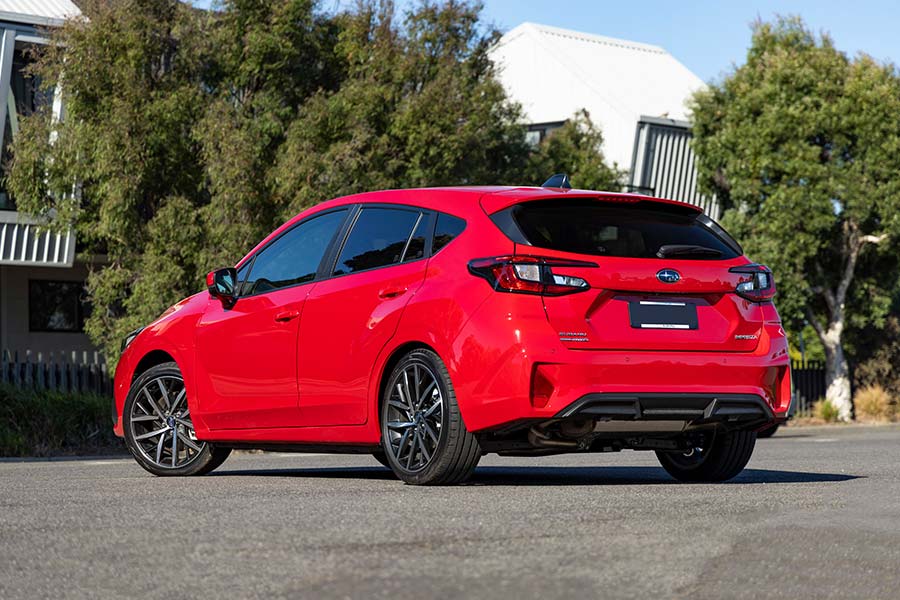
However, the novel engine type in the sixth generation Impreza is unchanged from the preceding model, which means power and torque outputs (115kW/196Nm) remain unchanged. That said, it’s still got competitive muscle compared to Japanese and Korean rivals.
Power is transferred to all four wheels via an automatic CVT (continuously variable transmission) that has eight ‘stepped’ gears if you tap on the steering wheel-mounted paddle shifters.
How fuel-efficient is the Subaru Impreza?
Because the Impreza has an AWD system it’s a bit heavier than most of its direct competitors and this negatively impacts fuel consumption. The 2024 Subaru Impreza 2.0S is happy to drink cheaper 91 octane petrol and has claimed fuel efficiency of 7.5L/100km, which is none too rosy these days.
Our testing saw record 9.0L/100km, which is not great and results in CO2 emissions higher than its 170g/km claim.
What is the Subaru Impreza like to drive?
The Impreza has always been at the top of its class for its all-round driving experience.
And it’s much the same with this new generation model, which even Subaru admits has been merely ‘finessed’ by its engineering division.
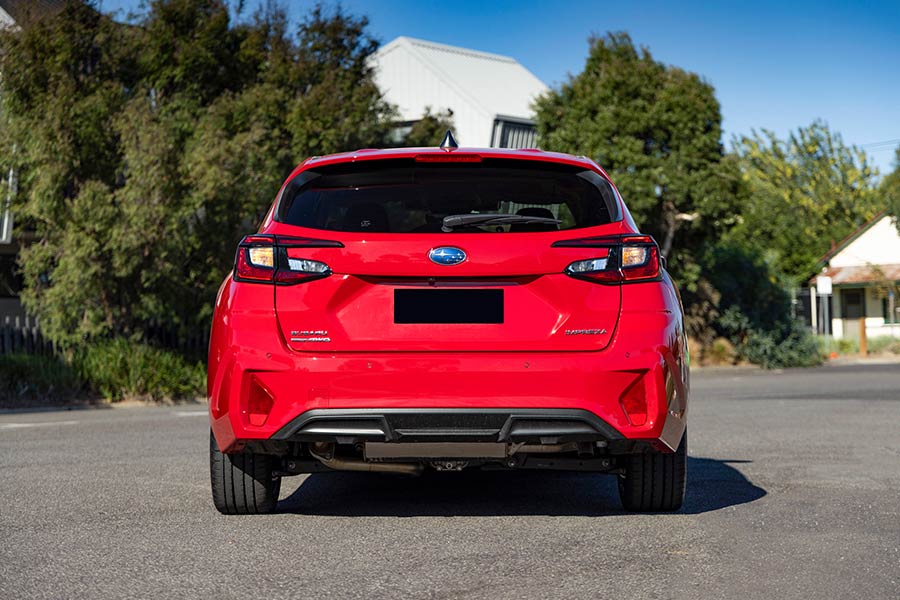
Thanks in part to its all-wheel drive system and the layout of its boxer engine (which Subaru touts as being symmetrical) that helps achieve a lower centre of gravity than more conventional configurations, the Impreza feels both nimble and surefooted that makes it enjoyable to drive in any condition.
With direct steering and compliant suspension, the chassis dynamics are respectable, and it doesn’t mind tucking into tighter corners. Indeed, unlike many newer rivals, it has more of an analogue, mechanical feel to the way it motivates, which adds a bit of character.
But some of that charm is dashed when you ask more of the engine, which is breathless and slow revving like the carryover powerplant it is. Granted, it works reasonably effectively with the CVT auto at low speeds, delivering satisfactory acceleration up to 60km/h, which makes it an adept suburban combatant.
But overtaking other cars on freeways and arterial roads at 80 or 100km/h reveals a level of lethargy in both the dated engine and transmission.
It’s a confident car when it rains and on dirt roads thanks to the AWD system, providing secure roadholding. Ride comfort is pretty good too, the suspension smoothing out potholes and poor-quality roads with relative ease.
Minor changes to the inner frame of the Subaru Global Platform architecture, which all the critical mechanical components are bolted to, are supposed to improve body rigidity while making the cabin a bit quieter, but without a back-to-back test with its predecessor it’s impossible to verify Subaru’s claims.
It certainly doesn’t feel quieter. The engine and CVT make a racket when revved and there’s noticeable wind noise around the windscreen and mirrors at higher speeds too.
Driving the Impreza is pleasingly effortless, if a little dull, and the soulless CVT and dated engine make it feel a generation behind more modern alternatives.
Can the Subaru Impreza go off-road?
Yes, it can! The AWD system is quite capable on dirt roads and can tackle challenging climbs that its rivals cannot. But it’s not a four-wheel drive in the same vein as a rugged ute or LandCruiser, as its ability is limited by its low ride height, with just 130mm of ground clearance meaning it’ll get snagged on rocks and washed-out ruts quick smart.
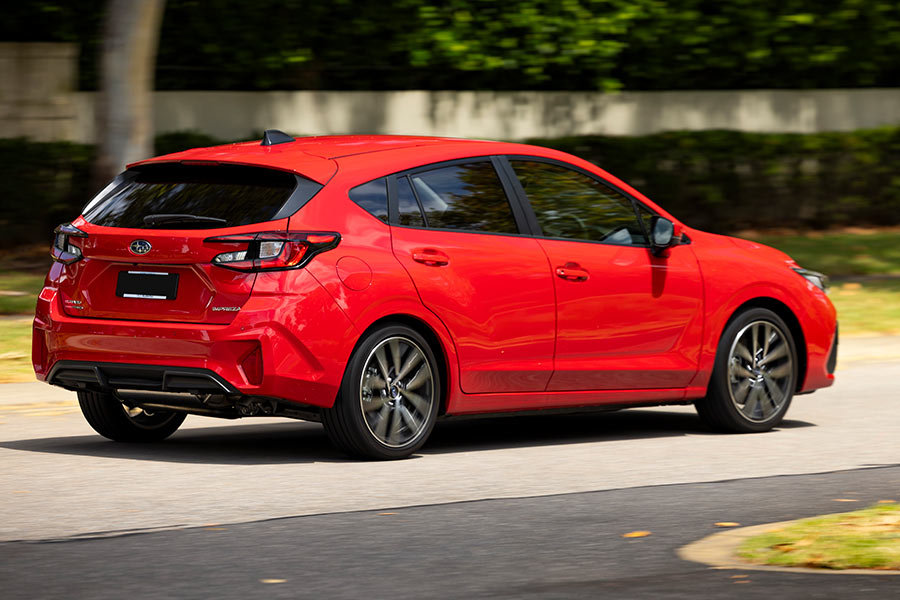
After all, this is a passenger car – not an SUV – albeit one with an above-average ability to traverse muddy roads or wet, grassy paddocks.
Should I buy a Subaru Impreza?
Subaru has very loyal owners, and many will automatically upgrade to the newer Impreza and appreciate the subtle improvements and, especially, the big digital display.
But, really, the 2024 Subaru Impreza feels more like a facelift than it does an all-new car as the promotional material insists. Granted, the cabin is a bit nicer, and safety tech is impressive.
But the aging powertrain, small boot and lack of rear-seat amenity don’t do it any favours. There’s little excitement or innovation here and, without a sedan option and no chance of a new WRX STI hero, there’s a sense that Subaru has either lost its mojo, is prioritising other models, or both.
There is nothing about the Impreza that would be deal-breaker for many new-car buyers, but the iconic nameplate deserves more than just a luke-warm update, and there are better small cars in terms of performance, value, economy, style, and substance.
Die-hard Subaru advocates might not be disappointed, but everyone else may find the 2024 Subaru Impreza stuck in the past.
2024 Subaru Impreza 2.0S at a glance:
Editor’s Rating: 6.9/10
| Price: $37,990 (plus on-road costs) |
Transmission: Continuously variable automatic with eight stepped ‘ratios’ |
| Available: Now |
Fuel: 7.5L/100km (ADR Combined) |
| Engine: 2.0-litre four-cylinder petrol |
CO2: 170g/km (ADR Combined) |
| Output: 115kW/196Nm |
Safety Rating: Not tested |
Disclaimer: Images supplied by carsales.
This article was prepared by an independent author. The information contained in this article represents the views and opinions of the original author, and is based on research carried out by the original author. The appearance of the article on Maxxia's website does not constitute an endorsement of its content by Maxxia in any way. The article has been made available for informational purposes only and should not be taken as advice. While all reasonable care has been taken to ensure that the statements made by the original author in the article are fair and accurate, Maxxia does not guarantee or warrant the accuracy or completeness of this information and will not be liable for, or in connection with, any loss or damage suffered as a result of any inaccuracies, errors or omissions or your reliance on this information. You should independently research and verify information before making any decision in respect of a vehicle.

